Business Law Report: Analysis of UK Business Law and Regulations
VerifiedAdded on 2020/06/06
|16
|4986
|352
Report
AI Summary
This report provides a comprehensive overview of business law in the UK, examining various sources of law, including legislation, common law, and EU law, and the role of the government in law-making. It delves into specific areas such as the Companies Act 2006 and its implications for businesses. The report further analyzes the impact of employment and contract law, highlighting the rights of employees and the legal obligations of employers. It discusses legal solutions for business problems, including the importance of following legal aspects such as the Companies Act, and providing legal solutions for business problems, including the importance of following legal aspects. The report also explores the effectiveness of the legal system and provides recommendations for legal solutions, comparing different national legal systems. The report emphasizes the importance of complying with legal frameworks to ensure fair business practices and protect both businesses and consumers.
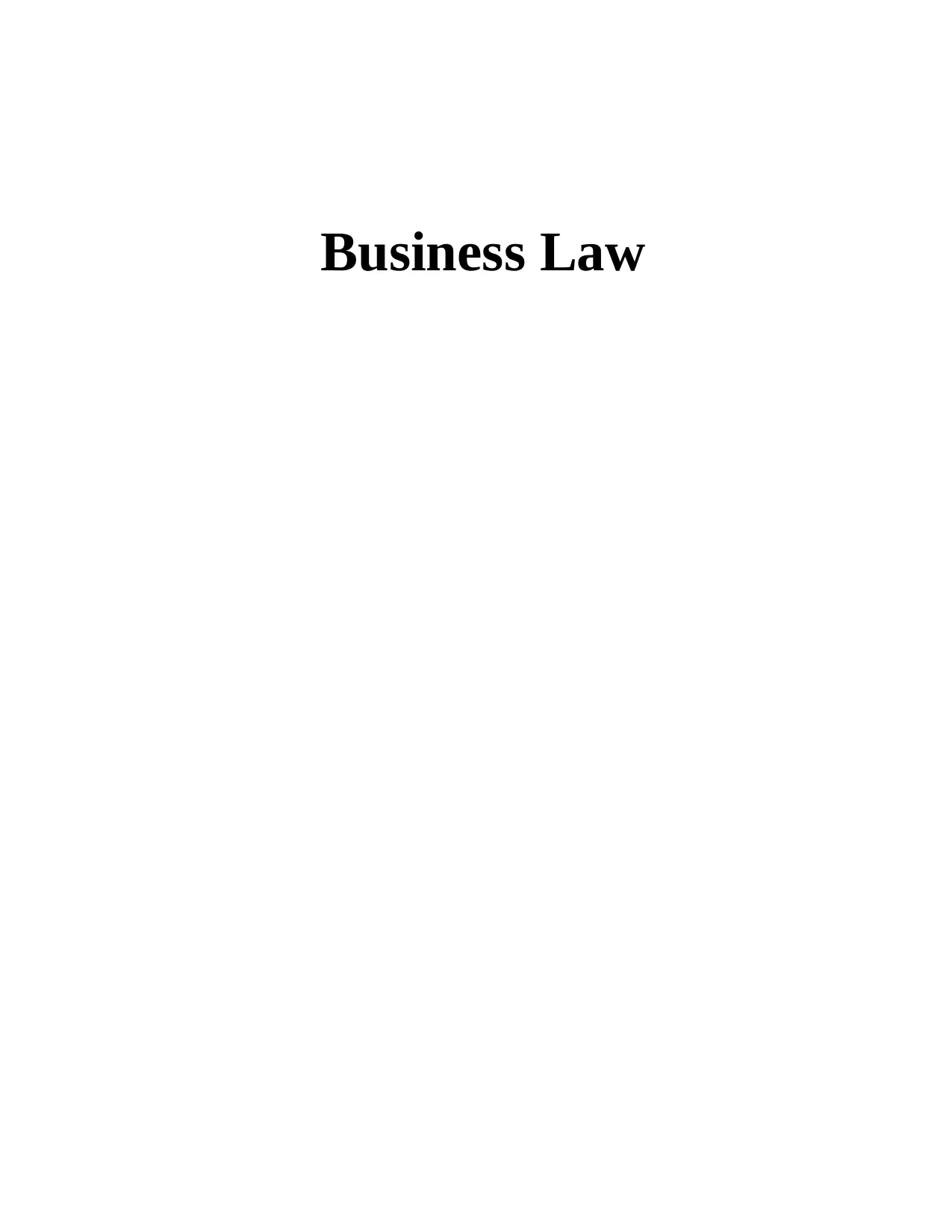
Business Law
Paraphrase This Document
Need a fresh take? Get an instant paraphrase of this document with our AI Paraphraser
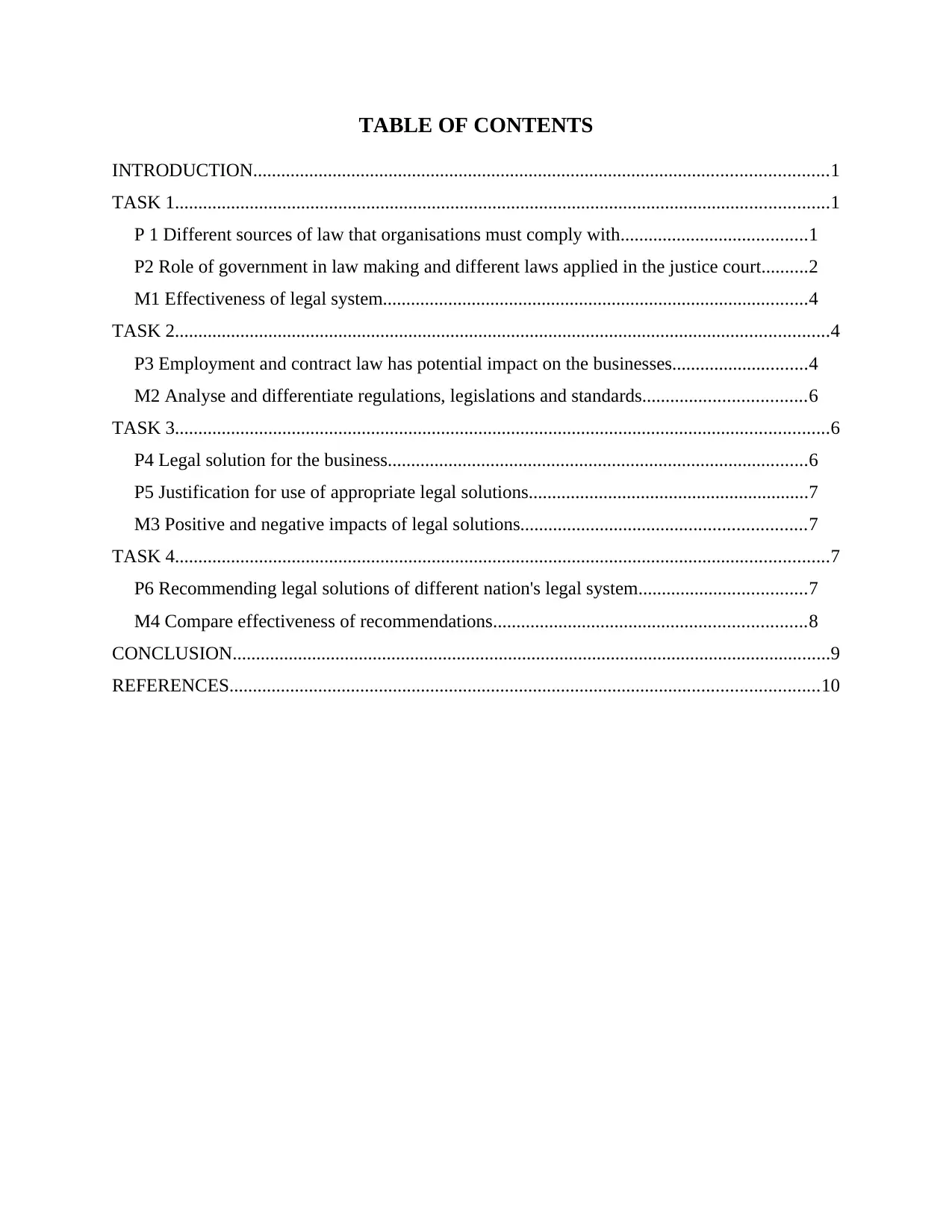
TABLE OF CONTENTS
INTRODUCTION...........................................................................................................................1
TASK 1............................................................................................................................................1
P 1 Different sources of law that organisations must comply with........................................1
P2 Role of government in law making and different laws applied in the justice court..........2
M1 Effectiveness of legal system...........................................................................................4
TASK 2............................................................................................................................................4
P3 Employment and contract law has potential impact on the businesses.............................4
M2 Analyse and differentiate regulations, legislations and standards...................................6
TASK 3............................................................................................................................................6
P4 Legal solution for the business..........................................................................................6
P5 Justification for use of appropriate legal solutions............................................................7
M3 Positive and negative impacts of legal solutions.............................................................7
TASK 4............................................................................................................................................7
P6 Recommending legal solutions of different nation's legal system....................................7
M4 Compare effectiveness of recommendations...................................................................8
CONCLUSION................................................................................................................................9
REFERENCES..............................................................................................................................10
INTRODUCTION...........................................................................................................................1
TASK 1............................................................................................................................................1
P 1 Different sources of law that organisations must comply with........................................1
P2 Role of government in law making and different laws applied in the justice court..........2
M1 Effectiveness of legal system...........................................................................................4
TASK 2............................................................................................................................................4
P3 Employment and contract law has potential impact on the businesses.............................4
M2 Analyse and differentiate regulations, legislations and standards...................................6
TASK 3............................................................................................................................................6
P4 Legal solution for the business..........................................................................................6
P5 Justification for use of appropriate legal solutions............................................................7
M3 Positive and negative impacts of legal solutions.............................................................7
TASK 4............................................................................................................................................7
P6 Recommending legal solutions of different nation's legal system....................................7
M4 Compare effectiveness of recommendations...................................................................8
CONCLUSION................................................................................................................................9
REFERENCES..............................................................................................................................10
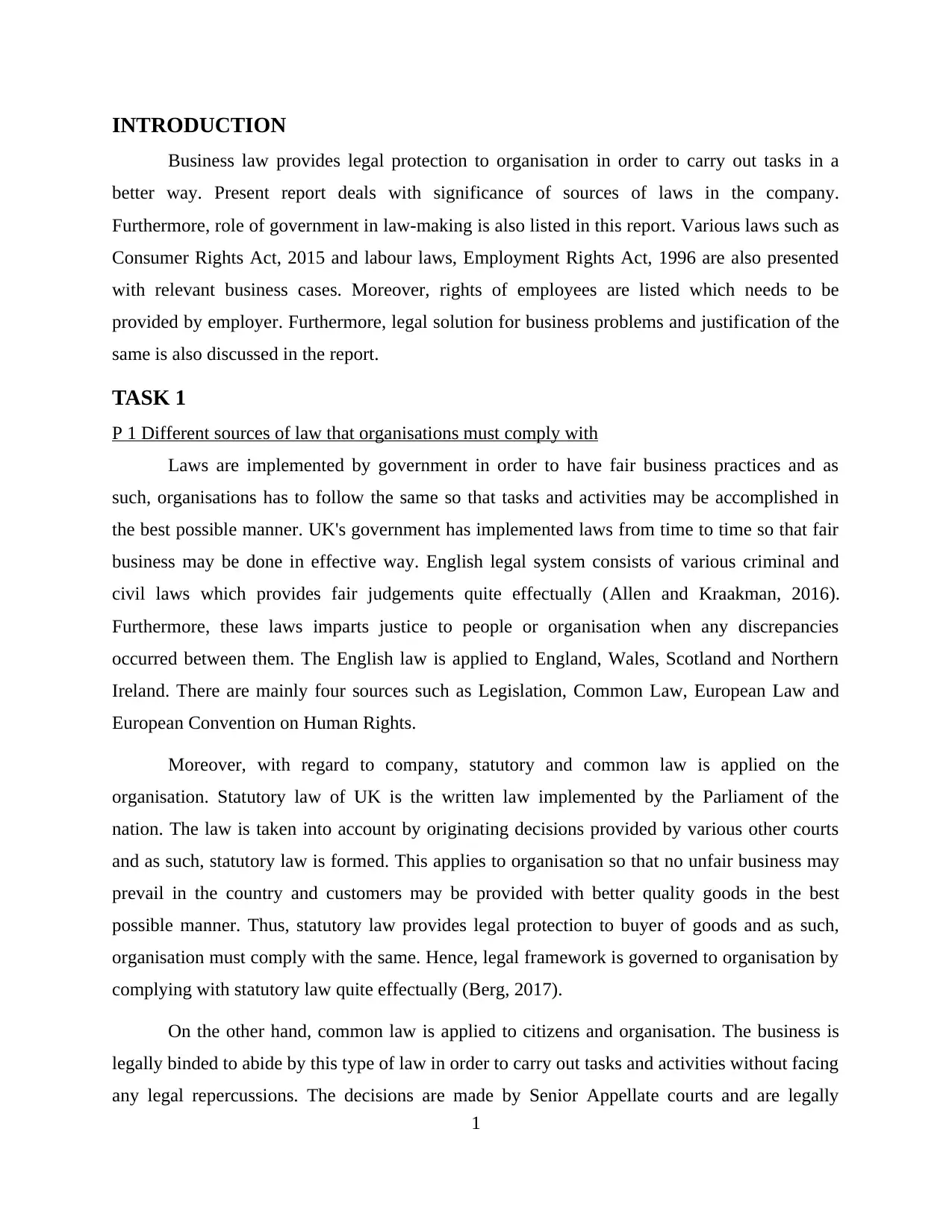
INTRODUCTION
Business law provides legal protection to organisation in order to carry out tasks in a
better way. Present report deals with significance of sources of laws in the company.
Furthermore, role of government in law-making is also listed in this report. Various laws such as
Consumer Rights Act, 2015 and labour laws, Employment Rights Act, 1996 are also presented
with relevant business cases. Moreover, rights of employees are listed which needs to be
provided by employer. Furthermore, legal solution for business problems and justification of the
same is also discussed in the report.
TASK 1
P 1 Different sources of law that organisations must comply with
Laws are implemented by government in order to have fair business practices and as
such, organisations has to follow the same so that tasks and activities may be accomplished in
the best possible manner. UK's government has implemented laws from time to time so that fair
business may be done in effective way. English legal system consists of various criminal and
civil laws which provides fair judgements quite effectually (Allen and Kraakman, 2016).
Furthermore, these laws imparts justice to people or organisation when any discrepancies
occurred between them. The English law is applied to England, Wales, Scotland and Northern
Ireland. There are mainly four sources such as Legislation, Common Law, European Law and
European Convention on Human Rights.
Moreover, with regard to company, statutory and common law is applied on the
organisation. Statutory law of UK is the written law implemented by the Parliament of the
nation. The law is taken into account by originating decisions provided by various other courts
and as such, statutory law is formed. This applies to organisation so that no unfair business may
prevail in the country and customers may be provided with better quality goods in the best
possible manner. Thus, statutory law provides legal protection to buyer of goods and as such,
organisation must comply with the same. Hence, legal framework is governed to organisation by
complying with statutory law quite effectually (Berg, 2017).
On the other hand, common law is applied to citizens and organisation. The business is
legally binded to abide by this type of law in order to carry out tasks and activities without facing
any legal repercussions. The decisions are made by Senior Appellate courts and are legally
1
Business law provides legal protection to organisation in order to carry out tasks in a
better way. Present report deals with significance of sources of laws in the company.
Furthermore, role of government in law-making is also listed in this report. Various laws such as
Consumer Rights Act, 2015 and labour laws, Employment Rights Act, 1996 are also presented
with relevant business cases. Moreover, rights of employees are listed which needs to be
provided by employer. Furthermore, legal solution for business problems and justification of the
same is also discussed in the report.
TASK 1
P 1 Different sources of law that organisations must comply with
Laws are implemented by government in order to have fair business practices and as
such, organisations has to follow the same so that tasks and activities may be accomplished in
the best possible manner. UK's government has implemented laws from time to time so that fair
business may be done in effective way. English legal system consists of various criminal and
civil laws which provides fair judgements quite effectually (Allen and Kraakman, 2016).
Furthermore, these laws imparts justice to people or organisation when any discrepancies
occurred between them. The English law is applied to England, Wales, Scotland and Northern
Ireland. There are mainly four sources such as Legislation, Common Law, European Law and
European Convention on Human Rights.
Moreover, with regard to company, statutory and common law is applied on the
organisation. Statutory law of UK is the written law implemented by the Parliament of the
nation. The law is taken into account by originating decisions provided by various other courts
and as such, statutory law is formed. This applies to organisation so that no unfair business may
prevail in the country and customers may be provided with better quality goods in the best
possible manner. Thus, statutory law provides legal protection to buyer of goods and as such,
organisation must comply with the same. Hence, legal framework is governed to organisation by
complying with statutory law quite effectually (Berg, 2017).
On the other hand, common law is applied to citizens and organisation. The business is
legally binded to abide by this type of law in order to carry out tasks and activities without facing
any legal repercussions. The decisions are made by Senior Appellate courts and are legally
1
⊘ This is a preview!⊘
Do you want full access?
Subscribe today to unlock all pages.

Trusted by 1+ million students worldwide
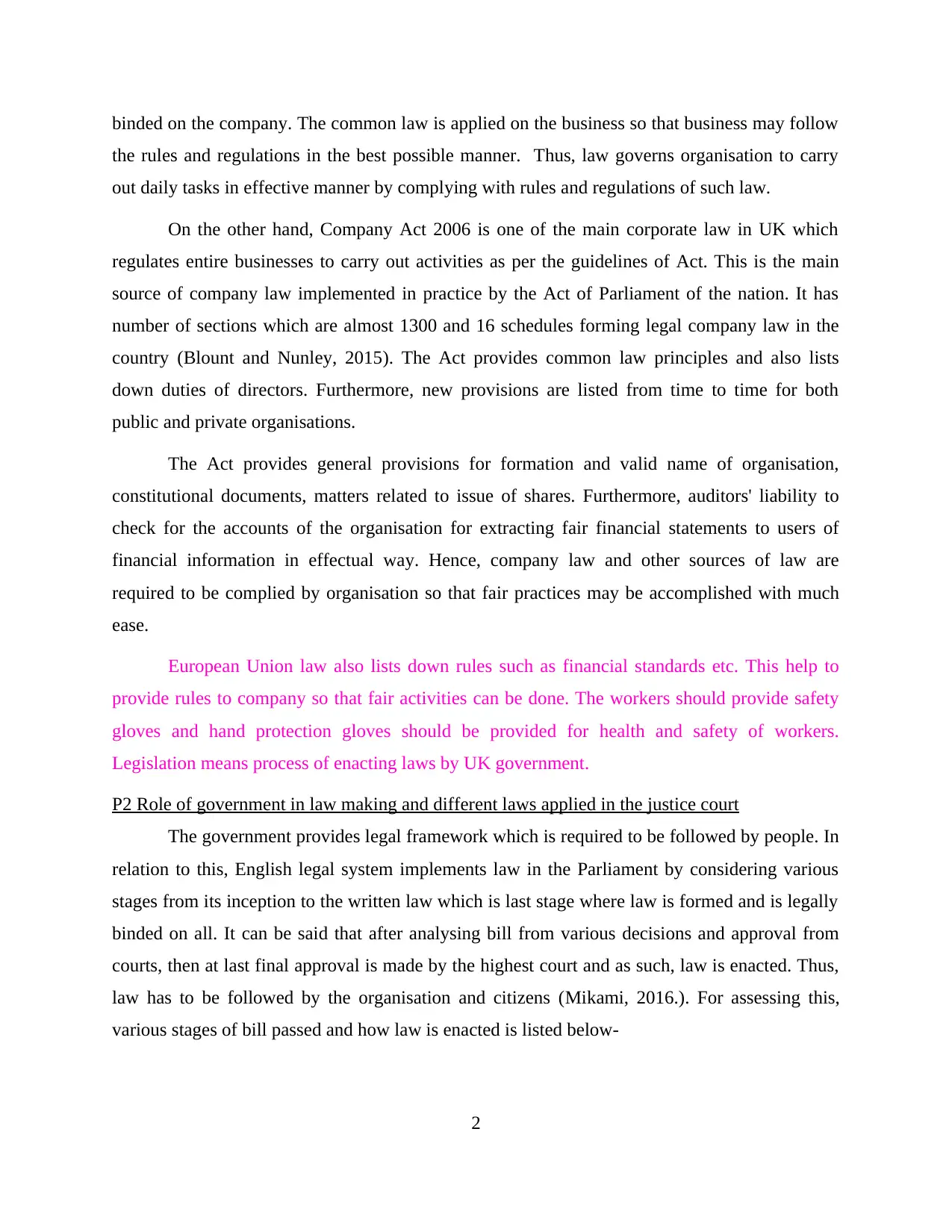
binded on the company. The common law is applied on the business so that business may follow
the rules and regulations in the best possible manner. Thus, law governs organisation to carry
out daily tasks in effective manner by complying with rules and regulations of such law.
On the other hand, Company Act 2006 is one of the main corporate law in UK which
regulates entire businesses to carry out activities as per the guidelines of Act. This is the main
source of company law implemented in practice by the Act of Parliament of the nation. It has
number of sections which are almost 1300 and 16 schedules forming legal company law in the
country (Blount and Nunley, 2015). The Act provides common law principles and also lists
down duties of directors. Furthermore, new provisions are listed from time to time for both
public and private organisations.
The Act provides general provisions for formation and valid name of organisation,
constitutional documents, matters related to issue of shares. Furthermore, auditors' liability to
check for the accounts of the organisation for extracting fair financial statements to users of
financial information in effectual way. Hence, company law and other sources of law are
required to be complied by organisation so that fair practices may be accomplished with much
ease.
European Union law also lists down rules such as financial standards etc. This help to
provide rules to company so that fair activities can be done. The workers should provide safety
gloves and hand protection gloves should be provided for health and safety of workers.
Legislation means process of enacting laws by UK government.
P2 Role of government in law making and different laws applied in the justice court
The government provides legal framework which is required to be followed by people. In
relation to this, English legal system implements law in the Parliament by considering various
stages from its inception to the written law which is last stage where law is formed and is legally
binded on all. It can be said that after analysing bill from various decisions and approval from
courts, then at last final approval is made by the highest court and as such, law is enacted. Thus,
law has to be followed by the organisation and citizens (Mikami, 2016.). For assessing this,
various stages of bill passed and how law is enacted is listed below-
2
the rules and regulations in the best possible manner. Thus, law governs organisation to carry
out daily tasks in effective manner by complying with rules and regulations of such law.
On the other hand, Company Act 2006 is one of the main corporate law in UK which
regulates entire businesses to carry out activities as per the guidelines of Act. This is the main
source of company law implemented in practice by the Act of Parliament of the nation. It has
number of sections which are almost 1300 and 16 schedules forming legal company law in the
country (Blount and Nunley, 2015). The Act provides common law principles and also lists
down duties of directors. Furthermore, new provisions are listed from time to time for both
public and private organisations.
The Act provides general provisions for formation and valid name of organisation,
constitutional documents, matters related to issue of shares. Furthermore, auditors' liability to
check for the accounts of the organisation for extracting fair financial statements to users of
financial information in effectual way. Hence, company law and other sources of law are
required to be complied by organisation so that fair practices may be accomplished with much
ease.
European Union law also lists down rules such as financial standards etc. This help to
provide rules to company so that fair activities can be done. The workers should provide safety
gloves and hand protection gloves should be provided for health and safety of workers.
Legislation means process of enacting laws by UK government.
P2 Role of government in law making and different laws applied in the justice court
The government provides legal framework which is required to be followed by people. In
relation to this, English legal system implements law in the Parliament by considering various
stages from its inception to the written law which is last stage where law is formed and is legally
binded on all. It can be said that after analysing bill from various decisions and approval from
courts, then at last final approval is made by the highest court and as such, law is enacted. Thus,
law has to be followed by the organisation and citizens (Mikami, 2016.). For assessing this,
various stages of bill passed and how law is enacted is listed below-
2
Paraphrase This Document
Need a fresh take? Get an instant paraphrase of this document with our AI Paraphraser
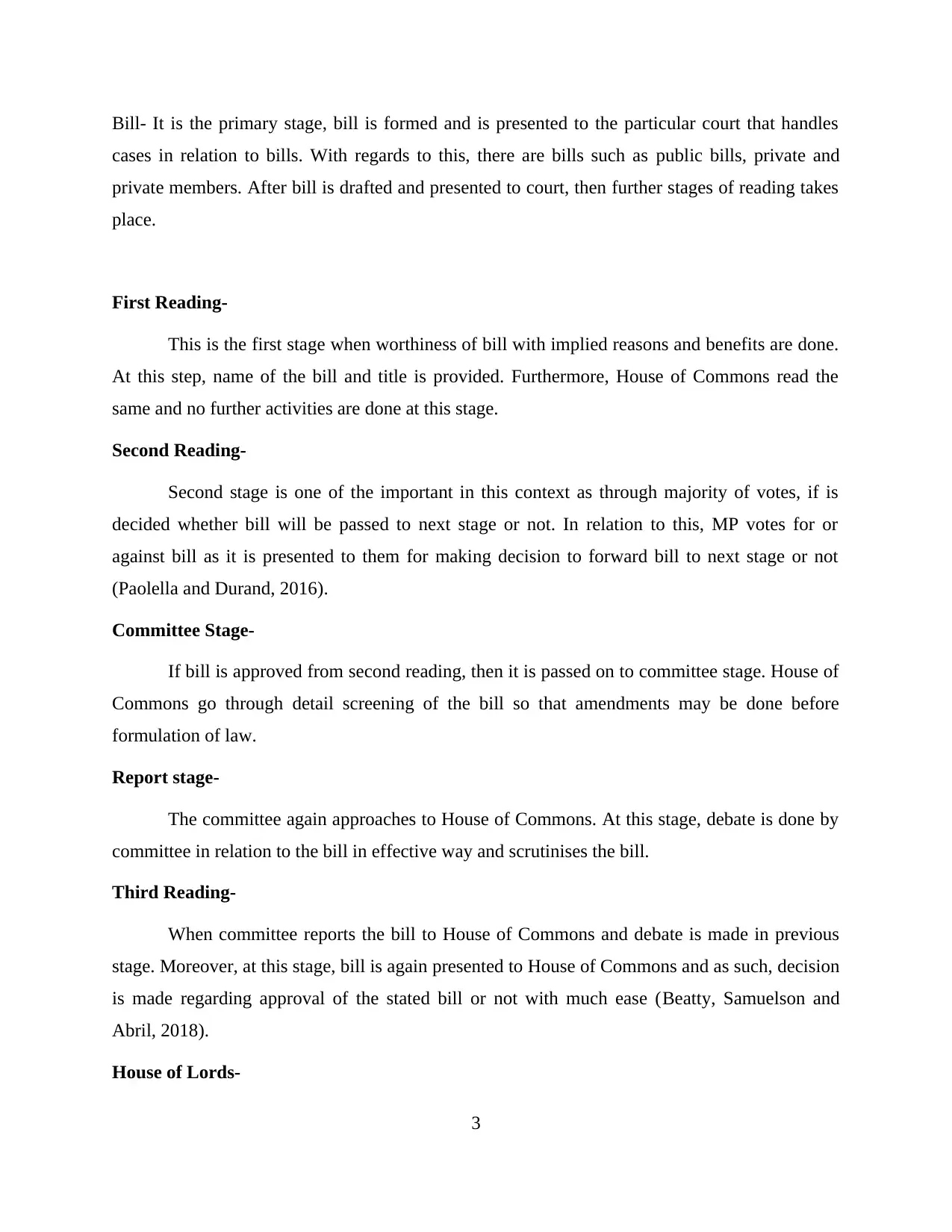
Bill- It is the primary stage, bill is formed and is presented to the particular court that handles
cases in relation to bills. With regards to this, there are bills such as public bills, private and
private members. After bill is drafted and presented to court, then further stages of reading takes
place.
First Reading-
This is the first stage when worthiness of bill with implied reasons and benefits are done.
At this step, name of the bill and title is provided. Furthermore, House of Commons read the
same and no further activities are done at this stage.
Second Reading-
Second stage is one of the important in this context as through majority of votes, if is
decided whether bill will be passed to next stage or not. In relation to this, MP votes for or
against bill as it is presented to them for making decision to forward bill to next stage or not
(Paolella and Durand, 2016).
Committee Stage-
If bill is approved from second reading, then it is passed on to committee stage. House of
Commons go through detail screening of the bill so that amendments may be done before
formulation of law.
Report stage-
The committee again approaches to House of Commons. At this stage, debate is done by
committee in relation to the bill in effective way and scrutinises the bill.
Third Reading-
When committee reports the bill to House of Commons and debate is made in previous
stage. Moreover, at this stage, bill is again presented to House of Commons and as such, decision
is made regarding approval of the stated bill or not with much ease (Beatty, Samuelson and
Abril, 2018).
House of Lords-
3
cases in relation to bills. With regards to this, there are bills such as public bills, private and
private members. After bill is drafted and presented to court, then further stages of reading takes
place.
First Reading-
This is the first stage when worthiness of bill with implied reasons and benefits are done.
At this step, name of the bill and title is provided. Furthermore, House of Commons read the
same and no further activities are done at this stage.
Second Reading-
Second stage is one of the important in this context as through majority of votes, if is
decided whether bill will be passed to next stage or not. In relation to this, MP votes for or
against bill as it is presented to them for making decision to forward bill to next stage or not
(Paolella and Durand, 2016).
Committee Stage-
If bill is approved from second reading, then it is passed on to committee stage. House of
Commons go through detail screening of the bill so that amendments may be done before
formulation of law.
Report stage-
The committee again approaches to House of Commons. At this stage, debate is done by
committee in relation to the bill in effective way and scrutinises the bill.
Third Reading-
When committee reports the bill to House of Commons and debate is made in previous
stage. Moreover, at this stage, bill is again presented to House of Commons and as such, decision
is made regarding approval of the stated bill or not with much ease (Beatty, Samuelson and
Abril, 2018).
House of Lords-
3
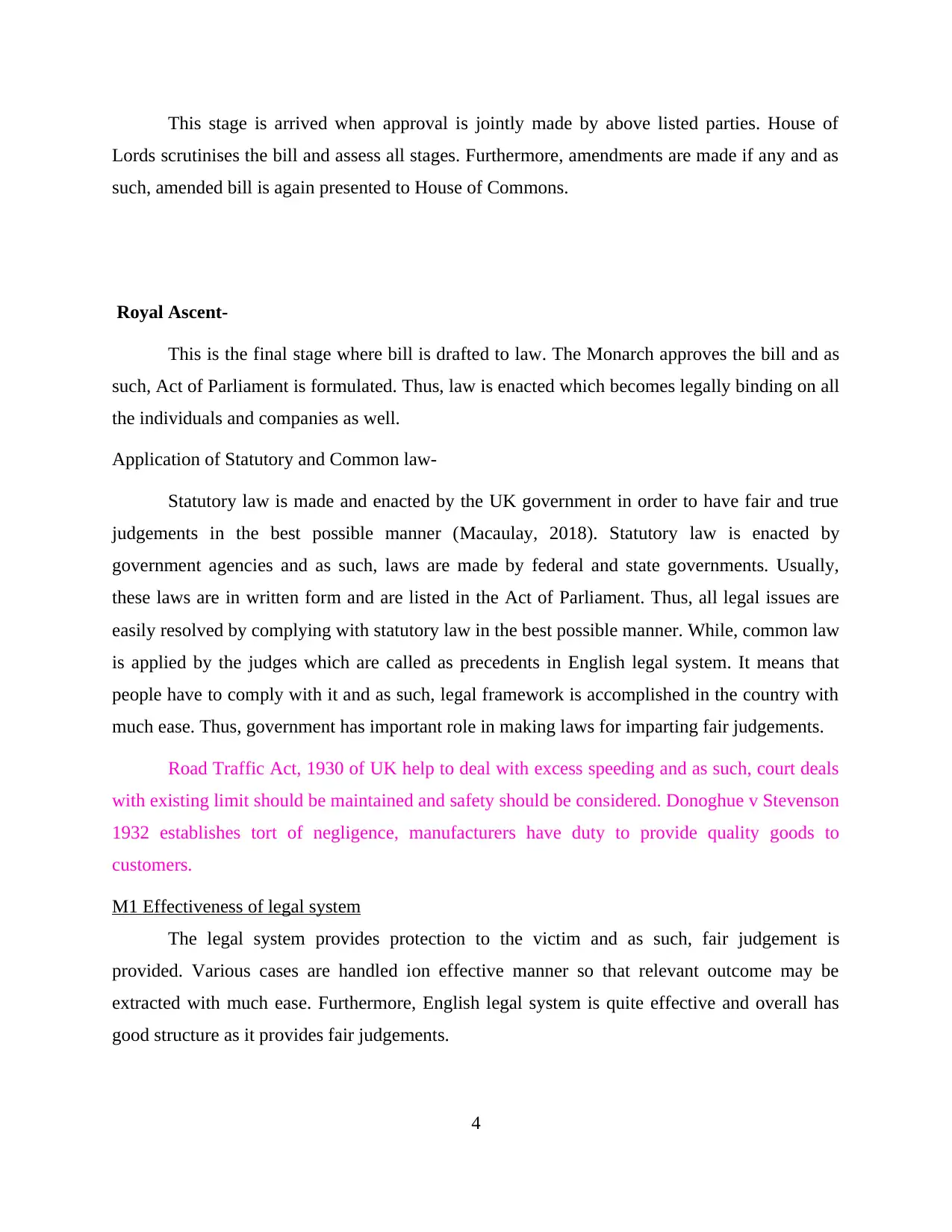
This stage is arrived when approval is jointly made by above listed parties. House of
Lords scrutinises the bill and assess all stages. Furthermore, amendments are made if any and as
such, amended bill is again presented to House of Commons.
Royal Ascent-
This is the final stage where bill is drafted to law. The Monarch approves the bill and as
such, Act of Parliament is formulated. Thus, law is enacted which becomes legally binding on all
the individuals and companies as well.
Application of Statutory and Common law-
Statutory law is made and enacted by the UK government in order to have fair and true
judgements in the best possible manner (Macaulay, 2018). Statutory law is enacted by
government agencies and as such, laws are made by federal and state governments. Usually,
these laws are in written form and are listed in the Act of Parliament. Thus, all legal issues are
easily resolved by complying with statutory law in the best possible manner. While, common law
is applied by the judges which are called as precedents in English legal system. It means that
people have to comply with it and as such, legal framework is accomplished in the country with
much ease. Thus, government has important role in making laws for imparting fair judgements.
Road Traffic Act, 1930 of UK help to deal with excess speeding and as such, court deals
with existing limit should be maintained and safety should be considered. Donoghue v Stevenson
1932 establishes tort of negligence, manufacturers have duty to provide quality goods to
customers.
M1 Effectiveness of legal system
The legal system provides protection to the victim and as such, fair judgement is
provided. Various cases are handled ion effective manner so that relevant outcome may be
extracted with much ease. Furthermore, English legal system is quite effective and overall has
good structure as it provides fair judgements.
4
Lords scrutinises the bill and assess all stages. Furthermore, amendments are made if any and as
such, amended bill is again presented to House of Commons.
Royal Ascent-
This is the final stage where bill is drafted to law. The Monarch approves the bill and as
such, Act of Parliament is formulated. Thus, law is enacted which becomes legally binding on all
the individuals and companies as well.
Application of Statutory and Common law-
Statutory law is made and enacted by the UK government in order to have fair and true
judgements in the best possible manner (Macaulay, 2018). Statutory law is enacted by
government agencies and as such, laws are made by federal and state governments. Usually,
these laws are in written form and are listed in the Act of Parliament. Thus, all legal issues are
easily resolved by complying with statutory law in the best possible manner. While, common law
is applied by the judges which are called as precedents in English legal system. It means that
people have to comply with it and as such, legal framework is accomplished in the country with
much ease. Thus, government has important role in making laws for imparting fair judgements.
Road Traffic Act, 1930 of UK help to deal with excess speeding and as such, court deals
with existing limit should be maintained and safety should be considered. Donoghue v Stevenson
1932 establishes tort of negligence, manufacturers have duty to provide quality goods to
customers.
M1 Effectiveness of legal system
The legal system provides protection to the victim and as such, fair judgement is
provided. Various cases are handled ion effective manner so that relevant outcome may be
extracted with much ease. Furthermore, English legal system is quite effective and overall has
good structure as it provides fair judgements.
4
⊘ This is a preview!⊘
Do you want full access?
Subscribe today to unlock all pages.

Trusted by 1+ million students worldwide
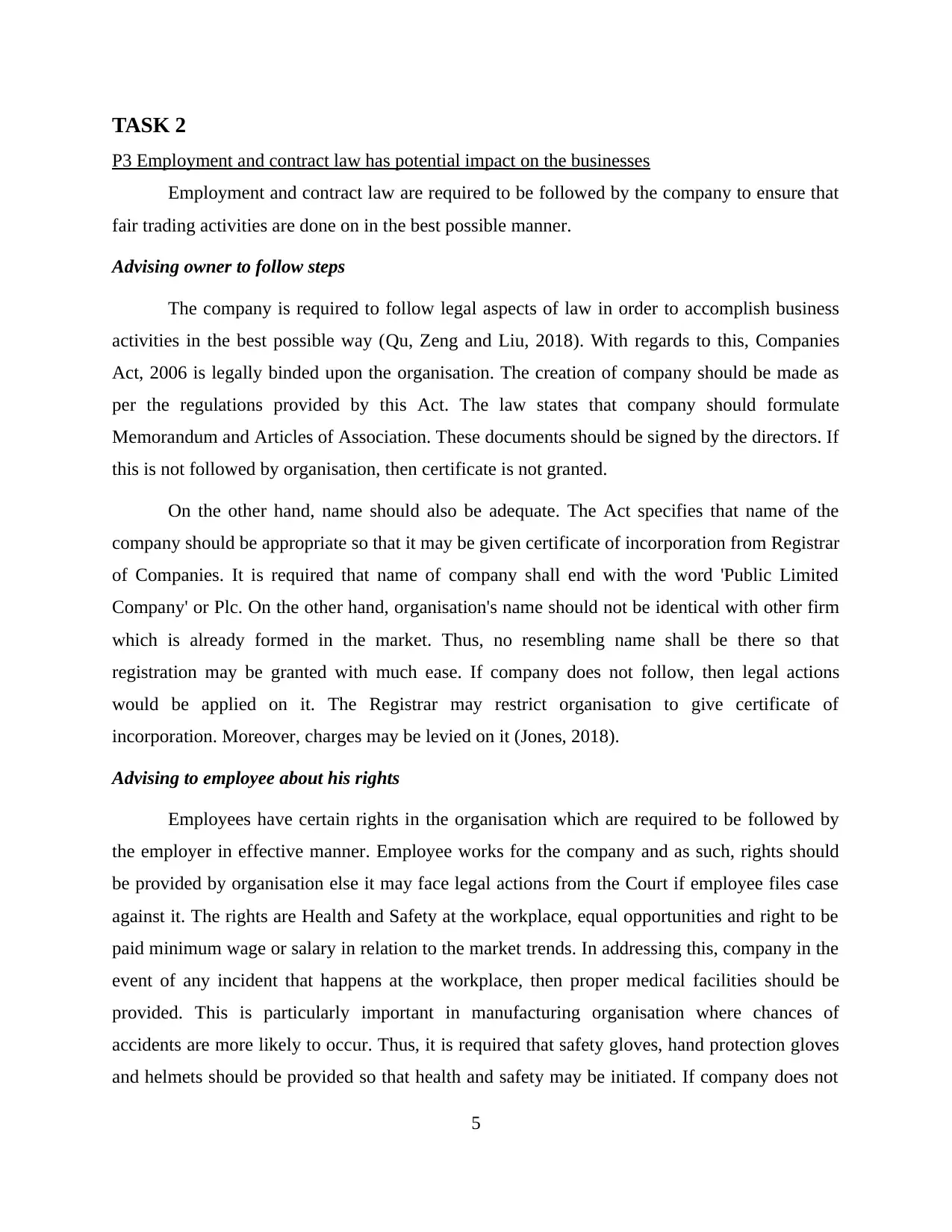
TASK 2
P3 Employment and contract law has potential impact on the businesses
Employment and contract law are required to be followed by the company to ensure that
fair trading activities are done on in the best possible manner.
Advising owner to follow steps
The company is required to follow legal aspects of law in order to accomplish business
activities in the best possible way (Qu, Zeng and Liu, 2018). With regards to this, Companies
Act, 2006 is legally binded upon the organisation. The creation of company should be made as
per the regulations provided by this Act. The law states that company should formulate
Memorandum and Articles of Association. These documents should be signed by the directors. If
this is not followed by organisation, then certificate is not granted.
On the other hand, name should also be adequate. The Act specifies that name of the
company should be appropriate so that it may be given certificate of incorporation from Registrar
of Companies. It is required that name of company shall end with the word 'Public Limited
Company' or Plc. On the other hand, organisation's name should not be identical with other firm
which is already formed in the market. Thus, no resembling name shall be there so that
registration may be granted with much ease. If company does not follow, then legal actions
would be applied on it. The Registrar may restrict organisation to give certificate of
incorporation. Moreover, charges may be levied on it (Jones, 2018).
Advising to employee about his rights
Employees have certain rights in the organisation which are required to be followed by
the employer in effective manner. Employee works for the company and as such, rights should
be provided by organisation else it may face legal actions from the Court if employee files case
against it. The rights are Health and Safety at the workplace, equal opportunities and right to be
paid minimum wage or salary in relation to the market trends. In addressing this, company in the
event of any incident that happens at the workplace, then proper medical facilities should be
provided. This is particularly important in manufacturing organisation where chances of
accidents are more likely to occur. Thus, it is required that safety gloves, hand protection gloves
and helmets should be provided so that health and safety may be initiated. If company does not
5
P3 Employment and contract law has potential impact on the businesses
Employment and contract law are required to be followed by the company to ensure that
fair trading activities are done on in the best possible manner.
Advising owner to follow steps
The company is required to follow legal aspects of law in order to accomplish business
activities in the best possible way (Qu, Zeng and Liu, 2018). With regards to this, Companies
Act, 2006 is legally binded upon the organisation. The creation of company should be made as
per the regulations provided by this Act. The law states that company should formulate
Memorandum and Articles of Association. These documents should be signed by the directors. If
this is not followed by organisation, then certificate is not granted.
On the other hand, name should also be adequate. The Act specifies that name of the
company should be appropriate so that it may be given certificate of incorporation from Registrar
of Companies. It is required that name of company shall end with the word 'Public Limited
Company' or Plc. On the other hand, organisation's name should not be identical with other firm
which is already formed in the market. Thus, no resembling name shall be there so that
registration may be granted with much ease. If company does not follow, then legal actions
would be applied on it. The Registrar may restrict organisation to give certificate of
incorporation. Moreover, charges may be levied on it (Jones, 2018).
Advising to employee about his rights
Employees have certain rights in the organisation which are required to be followed by
the employer in effective manner. Employee works for the company and as such, rights should
be provided by organisation else it may face legal actions from the Court if employee files case
against it. The rights are Health and Safety at the workplace, equal opportunities and right to be
paid minimum wage or salary in relation to the market trends. In addressing this, company in the
event of any incident that happens at the workplace, then proper medical facilities should be
provided. This is particularly important in manufacturing organisation where chances of
accidents are more likely to occur. Thus, it is required that safety gloves, hand protection gloves
and helmets should be provided so that health and safety may be initiated. If company does not
5
Paraphrase This Document
Need a fresh take? Get an instant paraphrase of this document with our AI Paraphraser
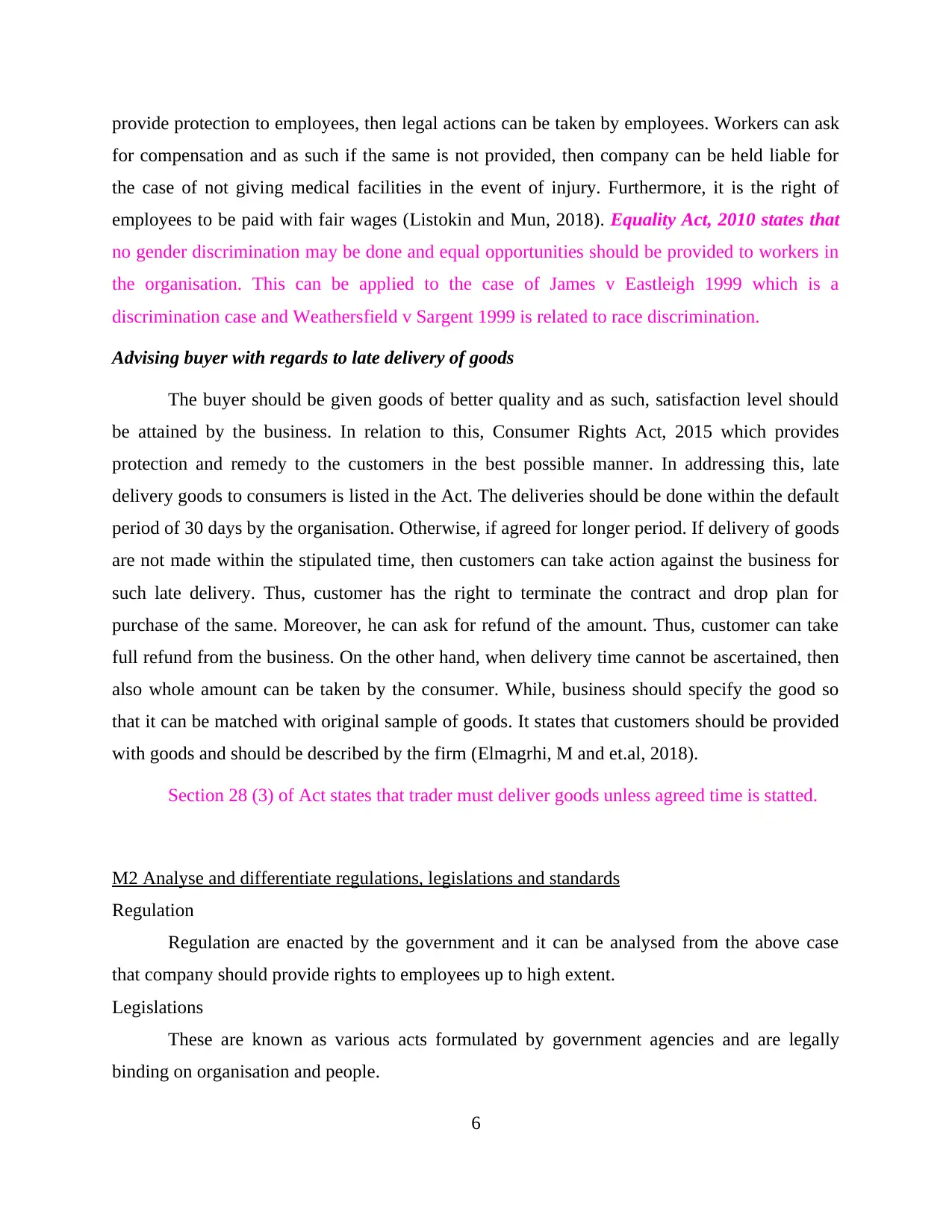
provide protection to employees, then legal actions can be taken by employees. Workers can ask
for compensation and as such if the same is not provided, then company can be held liable for
the case of not giving medical facilities in the event of injury. Furthermore, it is the right of
employees to be paid with fair wages (Listokin and Mun, 2018). Equality Act, 2010 states that
no gender discrimination may be done and equal opportunities should be provided to workers in
the organisation. This can be applied to the case of James v Eastleigh 1999 which is a
discrimination case and Weathersfield v Sargent 1999 is related to race discrimination.
Advising buyer with regards to late delivery of goods
The buyer should be given goods of better quality and as such, satisfaction level should
be attained by the business. In relation to this, Consumer Rights Act, 2015 which provides
protection and remedy to the customers in the best possible manner. In addressing this, late
delivery goods to consumers is listed in the Act. The deliveries should be done within the default
period of 30 days by the organisation. Otherwise, if agreed for longer period. If delivery of goods
are not made within the stipulated time, then customers can take action against the business for
such late delivery. Thus, customer has the right to terminate the contract and drop plan for
purchase of the same. Moreover, he can ask for refund of the amount. Thus, customer can take
full refund from the business. On the other hand, when delivery time cannot be ascertained, then
also whole amount can be taken by the consumer. While, business should specify the good so
that it can be matched with original sample of goods. It states that customers should be provided
with goods and should be described by the firm (Elmagrhi, M and et.al, 2018).
Section 28 (3) of Act states that trader must deliver goods unless agreed time is statted.
M2 Analyse and differentiate regulations, legislations and standards
Regulation
Regulation are enacted by the government and it can be analysed from the above case
that company should provide rights to employees up to high extent.
Legislations
These are known as various acts formulated by government agencies and are legally
binding on organisation and people.
6
for compensation and as such if the same is not provided, then company can be held liable for
the case of not giving medical facilities in the event of injury. Furthermore, it is the right of
employees to be paid with fair wages (Listokin and Mun, 2018). Equality Act, 2010 states that
no gender discrimination may be done and equal opportunities should be provided to workers in
the organisation. This can be applied to the case of James v Eastleigh 1999 which is a
discrimination case and Weathersfield v Sargent 1999 is related to race discrimination.
Advising buyer with regards to late delivery of goods
The buyer should be given goods of better quality and as such, satisfaction level should
be attained by the business. In relation to this, Consumer Rights Act, 2015 which provides
protection and remedy to the customers in the best possible manner. In addressing this, late
delivery goods to consumers is listed in the Act. The deliveries should be done within the default
period of 30 days by the organisation. Otherwise, if agreed for longer period. If delivery of goods
are not made within the stipulated time, then customers can take action against the business for
such late delivery. Thus, customer has the right to terminate the contract and drop plan for
purchase of the same. Moreover, he can ask for refund of the amount. Thus, customer can take
full refund from the business. On the other hand, when delivery time cannot be ascertained, then
also whole amount can be taken by the consumer. While, business should specify the good so
that it can be matched with original sample of goods. It states that customers should be provided
with goods and should be described by the firm (Elmagrhi, M and et.al, 2018).
Section 28 (3) of Act states that trader must deliver goods unless agreed time is statted.
M2 Analyse and differentiate regulations, legislations and standards
Regulation
Regulation are enacted by the government and it can be analysed from the above case
that company should provide rights to employees up to high extent.
Legislations
These are known as various acts formulated by government agencies and are legally
binding on organisation and people.
6
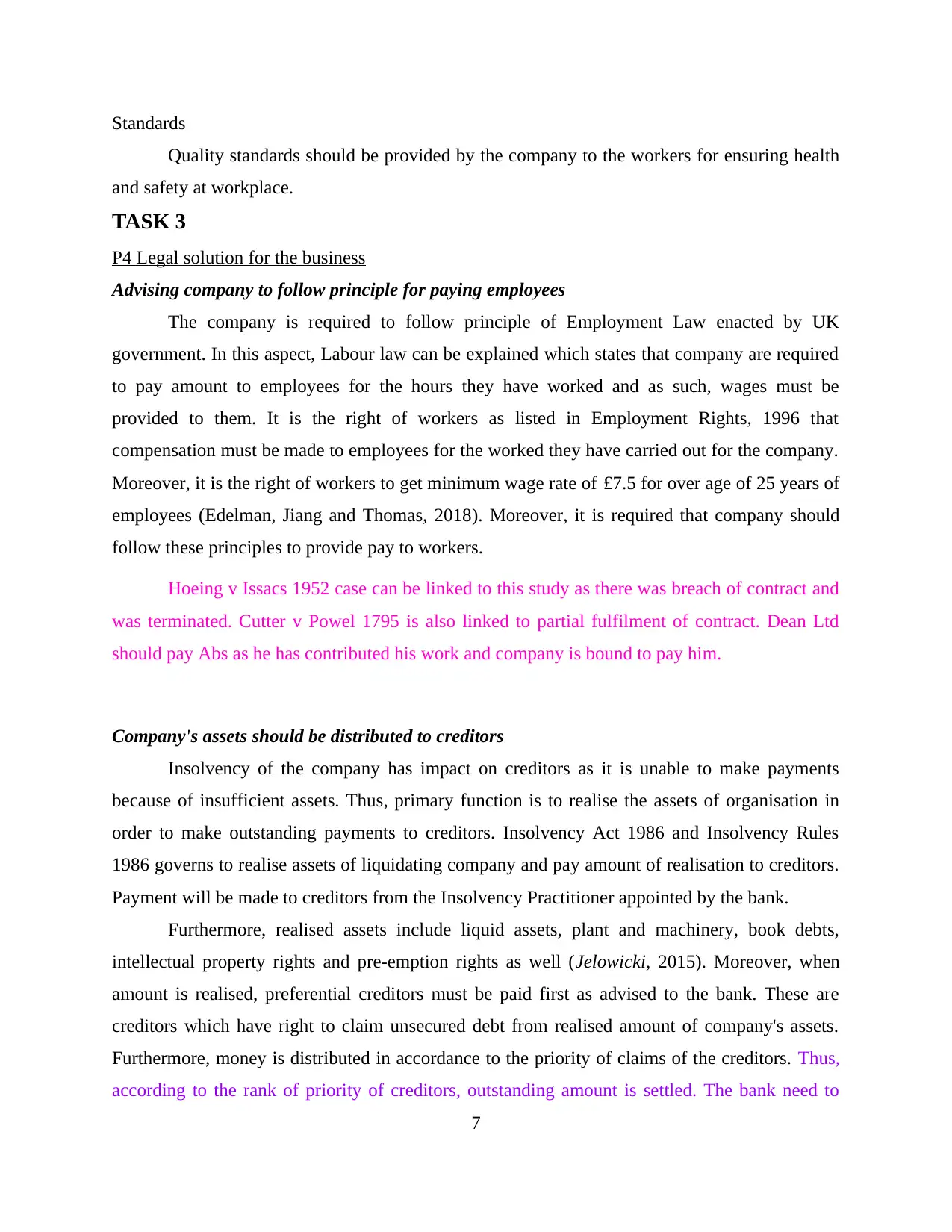
Standards
Quality standards should be provided by the company to the workers for ensuring health
and safety at workplace.
TASK 3
P4 Legal solution for the business
Advising company to follow principle for paying employees
The company is required to follow principle of Employment Law enacted by UK
government. In this aspect, Labour law can be explained which states that company are required
to pay amount to employees for the hours they have worked and as such, wages must be
provided to them. It is the right of workers as listed in Employment Rights, 1996 that
compensation must be made to employees for the worked they have carried out for the company.
Moreover, it is the right of workers to get minimum wage rate of £7.5 for over age of 25 years of
employees (Edelman, Jiang and Thomas, 2018). Moreover, it is required that company should
follow these principles to provide pay to workers.
Hoeing v Issacs 1952 case can be linked to this study as there was breach of contract and
was terminated. Cutter v Powel 1795 is also linked to partial fulfilment of contract. Dean Ltd
should pay Abs as he has contributed his work and company is bound to pay him.
Company's assets should be distributed to creditors
Insolvency of the company has impact on creditors as it is unable to make payments
because of insufficient assets. Thus, primary function is to realise the assets of organisation in
order to make outstanding payments to creditors. Insolvency Act 1986 and Insolvency Rules
1986 governs to realise assets of liquidating company and pay amount of realisation to creditors.
Payment will be made to creditors from the Insolvency Practitioner appointed by the bank.
Furthermore, realised assets include liquid assets, plant and machinery, book debts,
intellectual property rights and pre-emption rights as well (Jelowicki, 2015). Moreover, when
amount is realised, preferential creditors must be paid first as advised to the bank. These are
creditors which have right to claim unsecured debt from realised amount of company's assets.
Furthermore, money is distributed in accordance to the priority of claims of the creditors. Thus,
according to the rank of priority of creditors, outstanding amount is settled. The bank need to
7
Quality standards should be provided by the company to the workers for ensuring health
and safety at workplace.
TASK 3
P4 Legal solution for the business
Advising company to follow principle for paying employees
The company is required to follow principle of Employment Law enacted by UK
government. In this aspect, Labour law can be explained which states that company are required
to pay amount to employees for the hours they have worked and as such, wages must be
provided to them. It is the right of workers as listed in Employment Rights, 1996 that
compensation must be made to employees for the worked they have carried out for the company.
Moreover, it is the right of workers to get minimum wage rate of £7.5 for over age of 25 years of
employees (Edelman, Jiang and Thomas, 2018). Moreover, it is required that company should
follow these principles to provide pay to workers.
Hoeing v Issacs 1952 case can be linked to this study as there was breach of contract and
was terminated. Cutter v Powel 1795 is also linked to partial fulfilment of contract. Dean Ltd
should pay Abs as he has contributed his work and company is bound to pay him.
Company's assets should be distributed to creditors
Insolvency of the company has impact on creditors as it is unable to make payments
because of insufficient assets. Thus, primary function is to realise the assets of organisation in
order to make outstanding payments to creditors. Insolvency Act 1986 and Insolvency Rules
1986 governs to realise assets of liquidating company and pay amount of realisation to creditors.
Payment will be made to creditors from the Insolvency Practitioner appointed by the bank.
Furthermore, realised assets include liquid assets, plant and machinery, book debts,
intellectual property rights and pre-emption rights as well (Jelowicki, 2015). Moreover, when
amount is realised, preferential creditors must be paid first as advised to the bank. These are
creditors which have right to claim unsecured debt from realised amount of company's assets.
Furthermore, money is distributed in accordance to the priority of claims of the creditors. Thus,
according to the rank of priority of creditors, outstanding amount is settled. The bank need to
7
⊘ This is a preview!⊘
Do you want full access?
Subscribe today to unlock all pages.

Trusted by 1+ million students worldwide
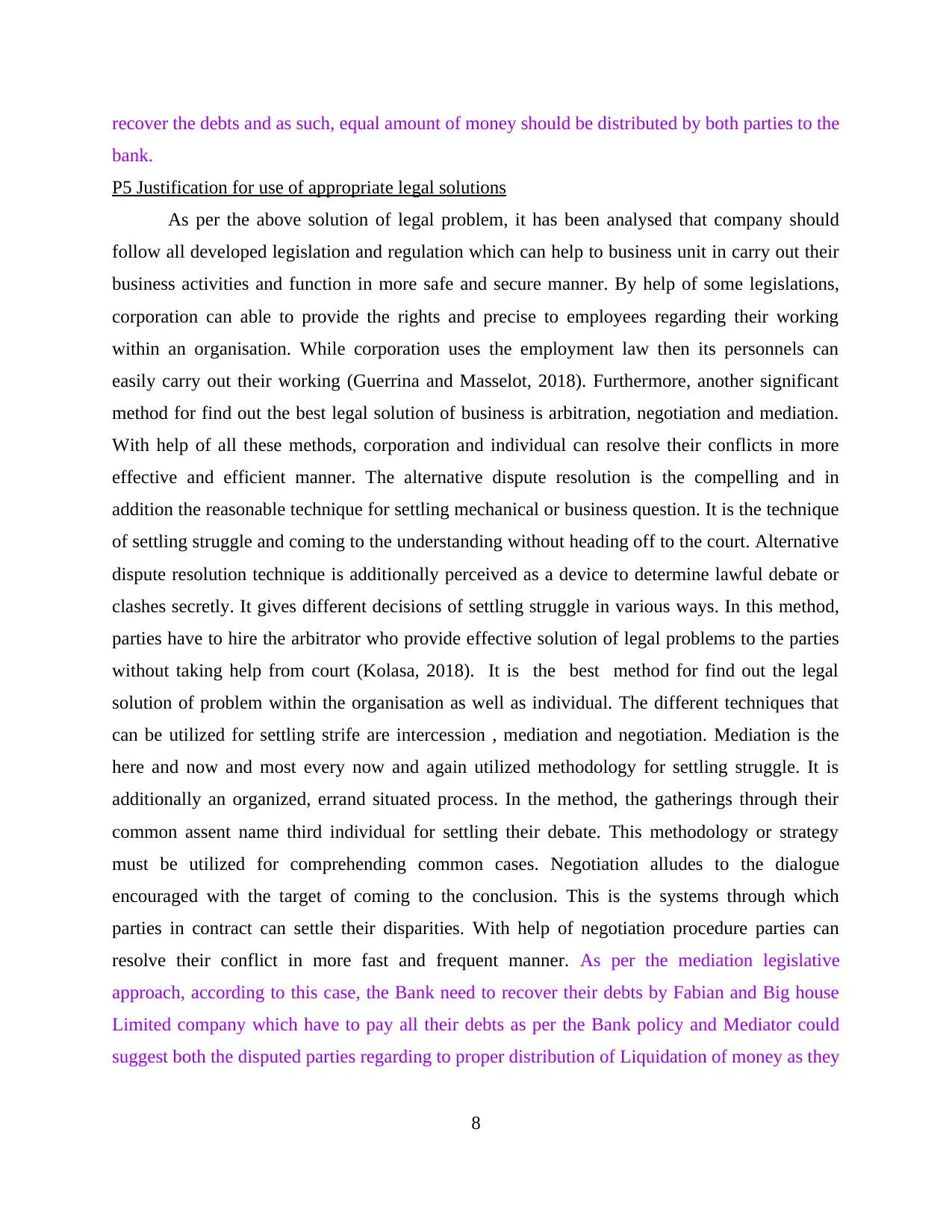
recover the debts and as such, equal amount of money should be distributed by both parties to the
bank.
P5 Justification for use of appropriate legal solutions
As per the above solution of legal problem, it has been analysed that company should
follow all developed legislation and regulation which can help to business unit in carry out their
business activities and function in more safe and secure manner. By help of some legislations,
corporation can able to provide the rights and precise to employees regarding their working
within an organisation. While corporation uses the employment law then its personnels can
easily carry out their working (Guerrina and Masselot, 2018). Furthermore, another significant
method for find out the best legal solution of business is arbitration, negotiation and mediation.
With help of all these methods, corporation and individual can resolve their conflicts in more
effective and efficient manner. The alternative dispute resolution is the compelling and in
addition the reasonable technique for settling mechanical or business question. It is the technique
of settling struggle and coming to the understanding without heading off to the court. Alternative
dispute resolution technique is additionally perceived as a device to determine lawful debate or
clashes secretly. It gives different decisions of settling struggle in various ways. In this method,
parties have to hire the arbitrator who provide effective solution of legal problems to the parties
without taking help from court (Kolasa, 2018). It is the best method for find out the legal
solution of problem within the organisation as well as individual. The different techniques that
can be utilized for settling strife are intercession , mediation and negotiation. Mediation is the
here and now and most every now and again utilized methodology for settling struggle. It is
additionally an organized, errand situated process. In the method, the gatherings through their
common assent name third individual for settling their debate. This methodology or strategy
must be utilized for comprehending common cases. Negotiation alludes to the dialogue
encouraged with the target of coming to the conclusion. This is the systems through which
parties in contract can settle their disparities. With help of negotiation procedure parties can
resolve their conflict in more fast and frequent manner. As per the mediation legislative
approach, according to this case, the Bank need to recover their debts by Fabian and Big house
Limited company which have to pay all their debts as per the Bank policy and Mediator could
suggest both the disputed parties regarding to proper distribution of Liquidation of money as they
8
bank.
P5 Justification for use of appropriate legal solutions
As per the above solution of legal problem, it has been analysed that company should
follow all developed legislation and regulation which can help to business unit in carry out their
business activities and function in more safe and secure manner. By help of some legislations,
corporation can able to provide the rights and precise to employees regarding their working
within an organisation. While corporation uses the employment law then its personnels can
easily carry out their working (Guerrina and Masselot, 2018). Furthermore, another significant
method for find out the best legal solution of business is arbitration, negotiation and mediation.
With help of all these methods, corporation and individual can resolve their conflicts in more
effective and efficient manner. The alternative dispute resolution is the compelling and in
addition the reasonable technique for settling mechanical or business question. It is the technique
of settling struggle and coming to the understanding without heading off to the court. Alternative
dispute resolution technique is additionally perceived as a device to determine lawful debate or
clashes secretly. It gives different decisions of settling struggle in various ways. In this method,
parties have to hire the arbitrator who provide effective solution of legal problems to the parties
without taking help from court (Kolasa, 2018). It is the best method for find out the legal
solution of problem within the organisation as well as individual. The different techniques that
can be utilized for settling strife are intercession , mediation and negotiation. Mediation is the
here and now and most every now and again utilized methodology for settling struggle. It is
additionally an organized, errand situated process. In the method, the gatherings through their
common assent name third individual for settling their debate. This methodology or strategy
must be utilized for comprehending common cases. Negotiation alludes to the dialogue
encouraged with the target of coming to the conclusion. This is the systems through which
parties in contract can settle their disparities. With help of negotiation procedure parties can
resolve their conflict in more fast and frequent manner. As per the mediation legislative
approach, according to this case, the Bank need to recover their debts by Fabian and Big house
Limited company which have to pay all their debts as per the Bank policy and Mediator could
suggest both the disputed parties regarding to proper distribution of Liquidation of money as they
8
Paraphrase This Document
Need a fresh take? Get an instant paraphrase of this document with our AI Paraphraser
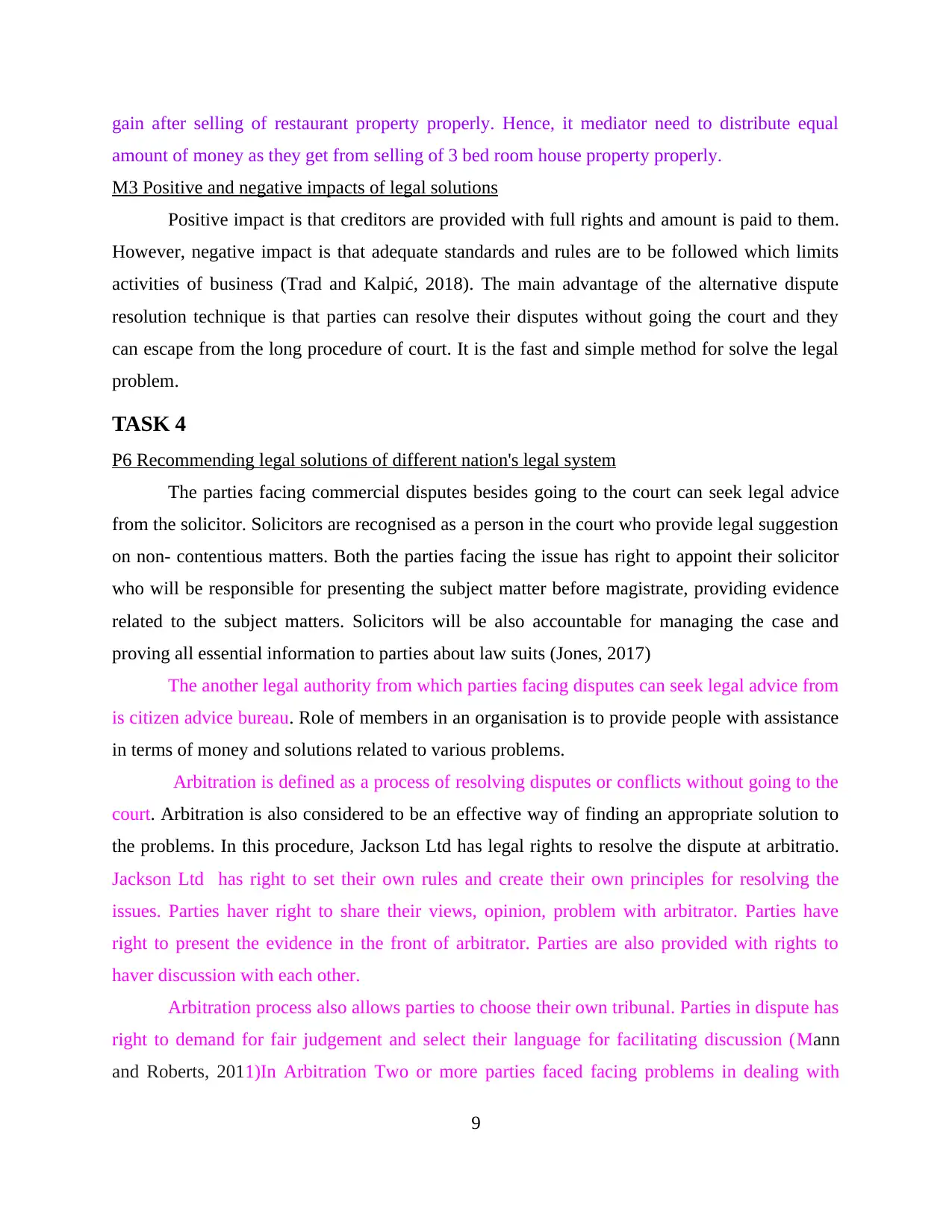
gain after selling of restaurant property properly. Hence, it mediator need to distribute equal
amount of money as they get from selling of 3 bed room house property properly.
M3 Positive and negative impacts of legal solutions
Positive impact is that creditors are provided with full rights and amount is paid to them.
However, negative impact is that adequate standards and rules are to be followed which limits
activities of business (Trad and Kalpić, 2018). The main advantage of the alternative dispute
resolution technique is that parties can resolve their disputes without going the court and they
can escape from the long procedure of court. It is the fast and simple method for solve the legal
problem.
TASK 4
P6 Recommending legal solutions of different nation's legal system
The parties facing commercial disputes besides going to the court can seek legal advice
from the solicitor. Solicitors are recognised as a person in the court who provide legal suggestion
on non- contentious matters. Both the parties facing the issue has right to appoint their solicitor
who will be responsible for presenting the subject matter before magistrate, providing evidence
related to the subject matters. Solicitors will be also accountable for managing the case and
proving all essential information to parties about law suits (Jones, 2017)
The another legal authority from which parties facing disputes can seek legal advice from
is citizen advice bureau. Role of members in an organisation is to provide people with assistance
in terms of money and solutions related to various problems.
Arbitration is defined as a process of resolving disputes or conflicts without going to the
court. Arbitration is also considered to be an effective way of finding an appropriate solution to
the problems. In this procedure, Jackson Ltd has legal rights to resolve the dispute at arbitratio.
Jackson Ltd has right to set their own rules and create their own principles for resolving the
issues. Parties haver right to share their views, opinion, problem with arbitrator. Parties have
right to present the evidence in the front of arbitrator. Parties are also provided with rights to
haver discussion with each other.
Arbitration process also allows parties to choose their own tribunal. Parties in dispute has
right to demand for fair judgement and select their language for facilitating discussion (Mann
and Roberts, 2011)In Arbitration Two or more parties faced facing problems in dealing with
9
amount of money as they get from selling of 3 bed room house property properly.
M3 Positive and negative impacts of legal solutions
Positive impact is that creditors are provided with full rights and amount is paid to them.
However, negative impact is that adequate standards and rules are to be followed which limits
activities of business (Trad and Kalpić, 2018). The main advantage of the alternative dispute
resolution technique is that parties can resolve their disputes without going the court and they
can escape from the long procedure of court. It is the fast and simple method for solve the legal
problem.
TASK 4
P6 Recommending legal solutions of different nation's legal system
The parties facing commercial disputes besides going to the court can seek legal advice
from the solicitor. Solicitors are recognised as a person in the court who provide legal suggestion
on non- contentious matters. Both the parties facing the issue has right to appoint their solicitor
who will be responsible for presenting the subject matter before magistrate, providing evidence
related to the subject matters. Solicitors will be also accountable for managing the case and
proving all essential information to parties about law suits (Jones, 2017)
The another legal authority from which parties facing disputes can seek legal advice from
is citizen advice bureau. Role of members in an organisation is to provide people with assistance
in terms of money and solutions related to various problems.
Arbitration is defined as a process of resolving disputes or conflicts without going to the
court. Arbitration is also considered to be an effective way of finding an appropriate solution to
the problems. In this procedure, Jackson Ltd has legal rights to resolve the dispute at arbitratio.
Jackson Ltd has right to set their own rules and create their own principles for resolving the
issues. Parties haver right to share their views, opinion, problem with arbitrator. Parties have
right to present the evidence in the front of arbitrator. Parties are also provided with rights to
haver discussion with each other.
Arbitration process also allows parties to choose their own tribunal. Parties in dispute has
right to demand for fair judgement and select their language for facilitating discussion (Mann
and Roberts, 2011)In Arbitration Two or more parties faced facing problems in dealing with
9
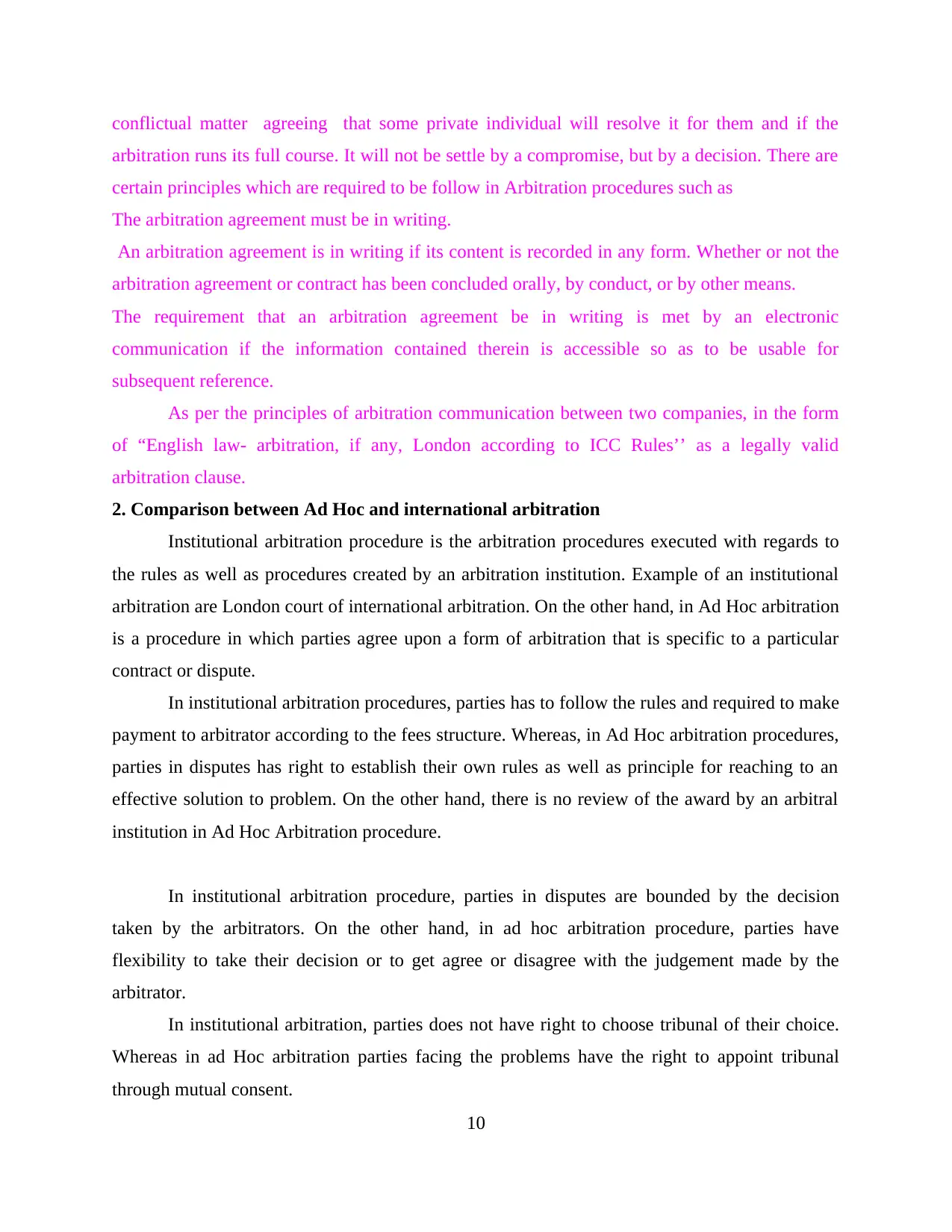
conflictual matter agreeing that some private individual will resolve it for them and if the
arbitration runs its full course. It will not be settle by a compromise, but by a decision. There are
certain principles which are required to be follow in Arbitration procedures such as
The arbitration agreement must be in writing.
An arbitration agreement is in writing if its content is recorded in any form. Whether or not the
arbitration agreement or contract has been concluded orally, by conduct, or by other means.
The requirement that an arbitration agreement be in writing is met by an electronic
communication if the information contained therein is accessible so as to be usable for
subsequent reference.
As per the principles of arbitration communication between two companies, in the form
of “English law- arbitration, if any, London according to ICC Rules’’ as a legally valid
arbitration clause.
2. Comparison between Ad Hoc and international arbitration
Institutional arbitration procedure is the arbitration procedures executed with regards to
the rules as well as procedures created by an arbitration institution. Example of an institutional
arbitration are London court of international arbitration. On the other hand, in Ad Hoc arbitration
is a procedure in which parties agree upon a form of arbitration that is specific to a particular
contract or dispute.
In institutional arbitration procedures, parties has to follow the rules and required to make
payment to arbitrator according to the fees structure. Whereas, in Ad Hoc arbitration procedures,
parties in disputes has right to establish their own rules as well as principle for reaching to an
effective solution to problem. On the other hand, there is no review of the award by an arbitral
institution in Ad Hoc Arbitration procedure.
In institutional arbitration procedure, parties in disputes are bounded by the decision
taken by the arbitrators. On the other hand, in ad hoc arbitration procedure, parties have
flexibility to take their decision or to get agree or disagree with the judgement made by the
arbitrator.
In institutional arbitration, parties does not have right to choose tribunal of their choice.
Whereas in ad Hoc arbitration parties facing the problems have the right to appoint tribunal
through mutual consent.
10
arbitration runs its full course. It will not be settle by a compromise, but by a decision. There are
certain principles which are required to be follow in Arbitration procedures such as
The arbitration agreement must be in writing.
An arbitration agreement is in writing if its content is recorded in any form. Whether or not the
arbitration agreement or contract has been concluded orally, by conduct, or by other means.
The requirement that an arbitration agreement be in writing is met by an electronic
communication if the information contained therein is accessible so as to be usable for
subsequent reference.
As per the principles of arbitration communication between two companies, in the form
of “English law- arbitration, if any, London according to ICC Rules’’ as a legally valid
arbitration clause.
2. Comparison between Ad Hoc and international arbitration
Institutional arbitration procedure is the arbitration procedures executed with regards to
the rules as well as procedures created by an arbitration institution. Example of an institutional
arbitration are London court of international arbitration. On the other hand, in Ad Hoc arbitration
is a procedure in which parties agree upon a form of arbitration that is specific to a particular
contract or dispute.
In institutional arbitration procedures, parties has to follow the rules and required to make
payment to arbitrator according to the fees structure. Whereas, in Ad Hoc arbitration procedures,
parties in disputes has right to establish their own rules as well as principle for reaching to an
effective solution to problem. On the other hand, there is no review of the award by an arbitral
institution in Ad Hoc Arbitration procedure.
In institutional arbitration procedure, parties in disputes are bounded by the decision
taken by the arbitrators. On the other hand, in ad hoc arbitration procedure, parties have
flexibility to take their decision or to get agree or disagree with the judgement made by the
arbitrator.
In institutional arbitration, parties does not have right to choose tribunal of their choice.
Whereas in ad Hoc arbitration parties facing the problems have the right to appoint tribunal
through mutual consent.
10
⊘ This is a preview!⊘
Do you want full access?
Subscribe today to unlock all pages.

Trusted by 1+ million students worldwide
1 out of 16
Related Documents
Your All-in-One AI-Powered Toolkit for Academic Success.
+13062052269
info@desklib.com
Available 24*7 on WhatsApp / Email
![[object Object]](/_next/static/media/star-bottom.7253800d.svg)
Unlock your academic potential
Copyright © 2020–2025 A2Z Services. All Rights Reserved. Developed and managed by ZUCOL.





